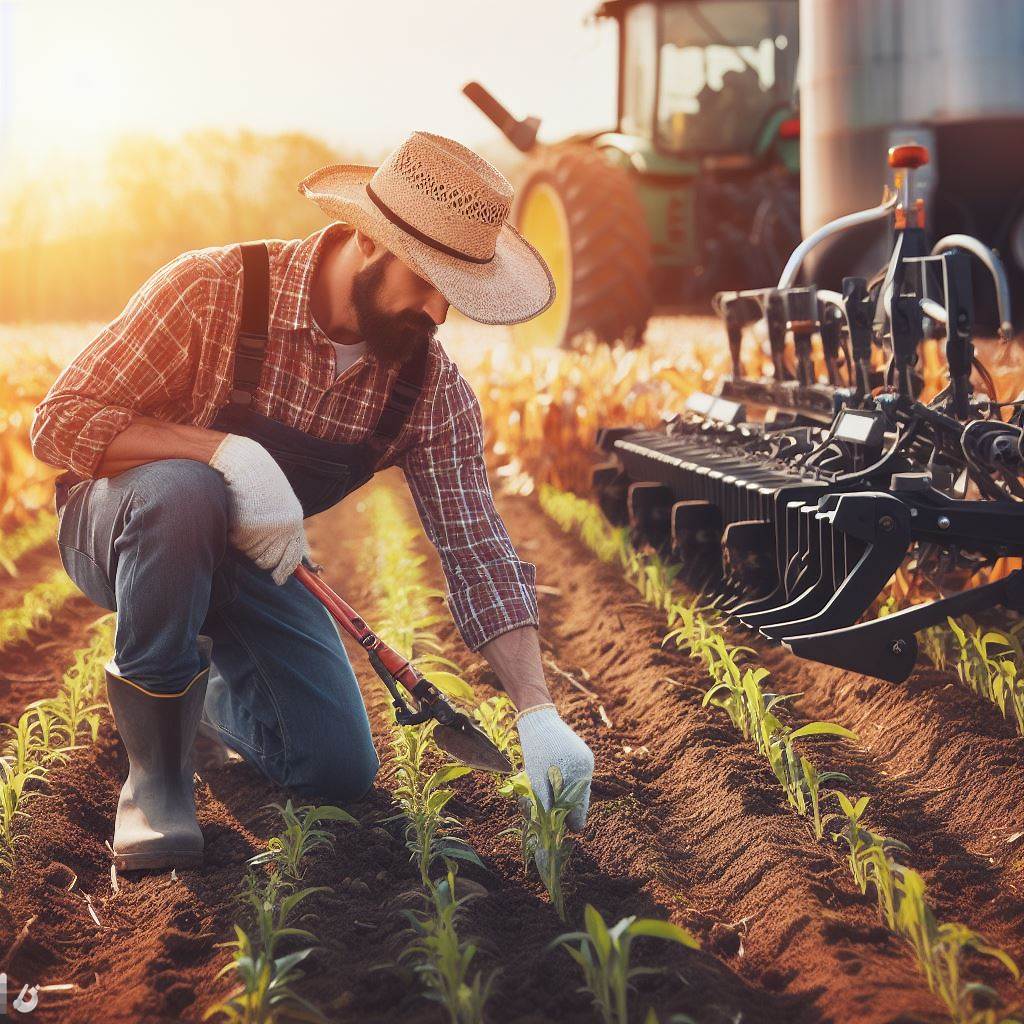Introduction
Soybeans are a crucial crop due to their high protein content and versatility in various industries.
In this blog section, we will explore effective techniques for promoting healthy soybean growth.
Proper soil preparation includes testing pH levels, adding organic matter, and ensuring adequate drainage.
Choosing high-quality seeds and planting them at the appropriate depth and spacing are vital for optimal growth.
Balancing soil nutrients through fertilization and addressing deficiencies through supplementation is crucial for healthy soybean growth.
Implementing effective weed management strategies, such as herbicide application, helps prevent competition for nutrients and sunlight.
Identifying and addressing common diseases and pests, like soybean cyst nematodes and aphids, is essential for crop health.
Proper irrigation techniques and managing water availability help prevent water stress and promote healthy root development.
Regular monitoring and scouting for signs of stress, diseases, or pests enable early intervention and improve overall crop health.
Implementing proper harvesting techniques and storage practices ensure the quality and longevity of soybean crops.
By implementing these techniques, soybean growers can enhance yield, quality, and sustainability while promoting healthy soybean growth.
Selecting the right soybean variety
Factors to consider when choosing a soybean variety
Choosing the right soybean variety is essential for healthy crop growth.
Different soybean varieties thrive in different climate and soil conditions, have varying disease resistance capabilities, and offer varying yields.
Farmers must carefully consider these factors before making a selection.
Climate and soil conditions
The first factor to consider when choosing a soybean variety is the climate and soil conditions of the farming location.
Transform Your Agribusiness
Unlock your farm's potential with expert advice tailored to your needs. Get actionable steps that drive real results.
Get StartedSoybeans have different growth requirements and adaptability. Some varieties are better suited for cooler climates, while others thrive in warmer regions.
Similarly, certain varieties prefer well-drained soils, while others can tolerate heavier clay soils.
Matching the variety to the specific conditions of the farm ensures optimal growth and yield potential.
Disease resistance
Diseases can significantly impact soybean yield and quality.
Therefore, selecting a soybean variety with strong disease resistance is crucial.
Different soybean varieties have varying levels of resistance to common diseases such as soybean cyst nematode, bacterial blight, and white mold.
By choosing varieties with specific disease resistance traits, farmers can reduce the risk of crop loss and minimize the need for pesticide applications.
Yield potential
Yield potential is another important consideration when selecting a soybean variety.
Farmers aim to maximize their crop productivity and profitability, so choosing varieties with high yield potential is essential.
Yield potential can be influenced by factors such as genetics, maturity group, and overall vigor of the variety.
By consulting yield trial data and performance records, farmers can identify varieties that consistently demonstrate good yields and are suitable for their farm’s conditions.
Researching and consulting experts for guidance
While considering the factors mentioned above, it is advisable for farmers to conduct thorough research and seek guidance from agricultural experts.
Farmers can access information and resources from agricultural extension services, universities, seed companies, and other reliable sources.
Consulting experts and agronomists who have knowledge and experience with soybean production can provide valuable insights and recommendations based on local conditions and specific farming goals.
Additionally, farmers can attend field days, workshops, or conferences related to soybean production to learn about the latest research findings and best practices.
These events often provide opportunities for direct interaction with experts and peers, enabling farmers to gain practical knowledge and make informed decisions when selecting the most suitable soybean variety for their farm.
In fact, selecting the right soybean variety involves carefully considering factors such as climate and soil conditions, disease resistance, and yield potential.
Farmers should conduct thorough research and consult experts to make informed decisions that will contribute to healthy soybean growth and maximize crop productivity.
By making the right variety selection, farmers can set the stage for a successful soybean growing season.
Proper seed treatment and planting strategies
In order to achieve healthy soybean growth, proper seed treatment and planting strategies are essential.
By implementing these techniques, farmers can maximize their yield potential and reduce the risk of crop failure.
Benefits of seed treatment
Protection against diseases and pests
One of the primary benefits of seed treatment is the protection it provides against various diseases and pests.
Soybeans are vulnerable to a range of pathogens and insects that can cause significant damage to the crop.
Seed treatment involves applying fungicides and insecticides directly to the seeds, which creates a protective barrier against these threats.
Showcase Your Farming Business
Publish your professional farming services profile on our blog for a one-time fee of $200 and reach a dedicated audience of farmers and agribusiness owners.
Publish Your ProfileThis helps to minimize the chances of disease outbreaks and pest infestations, ensuring healthier plant growth.
Enhancement of germination and early growth
Seed treatment also plays a crucial role in enhancing germination and early growth.
Seeds treated with growth-enhancing substances, such as plant hormones and micronutrients, experience improved vigor and faster development.
These treatments stimulate root and shoot growth, enabling the soybean plants to establish themselves more efficiently after planting.
As a result, the crop can withstand environmental stressors and achieve optimal growth throughout the growing season.
Ensuring optimal planting conditions
Seed depth and spacing considerations
Proper seed depth and spacing are crucial factors that can significantly affect soybean growth and yield.
Planting seeds at the correct depth allows for optimal root development and access to essential nutrients.
Generally, soybean seeds are planted around 1-2 inches deep to ensure adequate soil contact without burying them too deeply.
Additionally, spacing the seeds appropriately ensures optimum light interception and reduces competition for resources among plants.
Timing and soil temperature requirements
Timing and soil temperature are critical considerations when planting soybeans.
Soybean plants thrive in warm soil conditions, with the optimal soil temperature for germination being around 50-86°F (10-30°C).
Planting too early, when the soil is still cold, can result in poor germination and stunted growth.
Therefore, it is essential to wait until the soil has sufficiently warmed up before planting the seeds.
Moreover, planting at the right time, considering the local climate and rainfall patterns, ensures that the young plants have ideal conditions for establishment and early development.
In review, implementing proper seed treatment and planting strategies is vital for healthy soybean growth.
The benefits of seed treatment, including protection against diseases and pests, as well as enhanced germination and early growth, contribute to overall crop health and yield.
Additionally, ensuring optimal planting conditions through seed depth and spacing considerations, along with timing and soil temperature requirements, further enhances the chances of achieving a successful soybean harvest.
By employing these techniques, farmers can optimize their soybean production and reap the benefits of a healthy and thriving crop.
Implementing effective weed management practices
Importance of weed control in soybean fields
Effective weed management is vital for soybean fields as weeds can severely impact soybean growth and yield.
Weeds compete with soybean plants for essential resources like nutrients, light, and water, reducing their overall performance.
Therefore, implementing proper weed control measures is essential to ensure healthy soybean growth.
Pre-emergent and post-emergent weed control options
One of the primary weed control options is the use of pre-emergent and post-emergent herbicides.
Pre-emergent herbicides are applied before weed emergence, creating a barrier that inhibits weed growth.
These herbicides can be effective in preventing weed competition and reducing the need for post-emergent applications.
Post-emergent herbicides, on the other hand, are applied after weed emergence.
They target existing weeds, inhibiting their growth and preventing further damage to the soybean crop.
It is important to choose herbicides that effectively control the weed species present in the field and follow label instructions for proper application.
Integrated Weed Management (IWM) strategies
Integrated Weed Management (IWM) strategies combine different practices to control weeds and minimize herbicide resistance.
This approach aims to target weeds from multiple angles, making it harder for them to develop resistance to specific herbicides.
Here are some effective IWM strategies:
Use of herbicides with different modes of action
Rotating herbicides with different modes of action helps prevent the development of herbicide-resistant weed populations.
This approach involves using multiple herbicides from different chemical groups throughout the growing season.
Crop rotation and cover cropping
Rotating soybeans with different crops disrupts the weed life cycle.
Different crops may have different weed control mechanisms, reducing the overall weed pressure.
Additionally, cover cropping can suppress weed growth by shading the soil and competing for resources.
Mechanical weed control
Mechanical methods like cultivation, rotary hoeing, and hand-weeding can be effective in removing weeds without relying solely on herbicides.
These methods are particularly useful in organic farming systems where herbicide options are limited.
However, care must be taken to avoid damaging the soybean crop during mechanical weed control operations.
Effective weed management requires a combination of these practices tailored to the specific weed species and field conditions.
Regular scouting and monitoring of weed populations are essential to identify the optimal timing and methods for weed control.
Showcase Your Farming Business
Publish your professional farming services profile on our blog for a one-time fee of $200 and reach a dedicated audience of farmers and agribusiness owners.
Publish Your ProfileBy implementing these weed management strategies, soybean growers can maximize crop yield and ensure healthy soybean growth.
Read: Drip Irrigation: Saving Water in Crop Fields
Nutrient management for soybean plants
In order to ensure healthy growth and maximize yield potential, it is crucial to implement proper nutrient management techniques for soybean plants.
This involves understanding the essential nutrients required by soybeans, conducting soil testing and analysis, adopting appropriate fertilization techniques, and adjusting nutrient management based on soil and plant health assessments.
Essential nutrients required by soybeans
Soybean plants require a range of essential nutrients to support their growth and development.
These include macronutrients such as nitrogen (N), phosphorus (P), and potassium (K), as well as micronutrients like iron, manganese, zinc, and copper.
Ensuring an adequate supply of these nutrients is vital for optimal soybean production.
Soil testing and analysis for nutrient deficiencies
Prior to planting soybeans, it is recommended to conduct a thorough soil test to determine the nutrient status of the field.
Soil samples should be collected from representative areas, and tested for nutrient levels and pH.
This information helps identify any nutrient deficiencies or imbalances that may exist, enabling appropriate corrective measures to be taken.
Proper fertilization techniques
Fertilizers play a crucial role in providing essential nutrients to soybean plants.
The following techniques should be employed for effective fertilization:
- Optimal nutrient application rates: Based on the soil test results, fertilizers should be applied at rates that meet the nutrient requirements of soybeans.
These rates can vary depending on the specific nutrient deficiencies present and the desired yield goals. - Timing of fertilizer application: It is important to apply fertilizers at the right time to maximize nutrient uptake by soybean plants.
Generally, a portion of the fertilizers should be applied during planting, while the remaining amount can be split into multiple applications during the growing season.
Adjusting nutrient management based on soil and plant health assessments
Regular soil and plant health assessments should be conducted throughout the growing season to monitor nutrient availability and plant performance.
If any nutrient deficiencies or imbalances are detected, appropriate adjustments should be made, such as altering fertilizer rates or using foliar sprays to provide a quick nutrient boost.
In brief, proper nutrient management is crucial for healthy soybean growth and a successful harvest.
By understanding the essential nutrients required by soybeans, conducting soil testing and analysis, adopting appropriate fertilization techniques, and adjusting nutrient management based on assessments, farmers can optimize soybean production and achieve higher yields.
Read: Effective Weed Control in Crop Cultivation

Monitoring and Managing Pests and Diseases
Common pests and diseases affecting soybeans:
- Aphids
- Spider mites
- Soybean cyst nematode
- Leafhoppers
- Whiteflies
- Soybean mosaic virus
- Phomopsis seed decay
- Brown stem rot
Regular scouting and monitoring of fields
Regular scouting and monitoring of fields is crucial to ensure the early detection of pests and diseases in soybean crops.
By identifying these problems early on, farmers can initiate appropriate management strategies to prevent yield losses and unnecessary applications of pesticides.
A wide range of pests and diseases can affect soybean crops.
Some of the common pests include aphids, spider mites, soybean cyst nematode, and leafhoppers.
These pests can cause significant damage to plants, hampering their growth and development.
In addition, diseases such as soybean mosaic virus, phomopsis seed decay, and brown stem rot can also have a detrimental impact on soybeans.
Integrated Pest Management (IPM) practices
Integrated Pest Management (IPM) practices offer an effective approach to deal with pests and diseases while minimizing the use of chemical pesticides.
IPM combines various control methods to keep pest populations below economic thresholds.
These methods include biological control, cultural practices, and judicious use of chemical control options.
Biological control methods
Biological control methods involve using natural enemies of pests to reduce their populations.
For example, ladybugs and lacewings are natural predators that feed on aphids and spider mites.
By attracting and promoting these beneficial insects, farmers can keep pest populations in check without relying solely on chemical pesticides.
Cultural practices to reduce pest habitats
Cultural practices play a significant role in reducing pest habitats.
Crop rotation is a common practice that involves alternating soybean crops with non-host plants, disrupting pest life cycles.
Additionally, removing crop residue from fields helps eliminate potential breeding grounds for pests and diseases.
Judicious use of chemical control options
While pesticides can be effective in controlling pests and diseases, their use should be judicious.
Farmers should carefully consider the economic threshold at which the potential damage from pests justifies the use of chemical control measures.
Using pesticides indiscriminately can harm beneficial insects, disrupt natural ecosystems, and lead to pesticide resistance in pests over time.
In a nutshell, monitoring and managing pests and diseases are critical for healthy soybean growth.
Regular scouting, early detection, and implementing integrated pest management practices are essential for effective pest and disease control.
By adopting these techniques, farmers can ensure the sustainable and profitable production of soybeans while minimizing the environmental impact of their agricultural practices.
Read: Soil pH and Its Impact on Crop Growth
Water management in soybean production
Importance of proper water management
Proper water management is crucial for healthy soybean growth and maximizing crop yield.
Showcase Your Farming Business
Publish your professional farming services profile on our blog for a one-time fee of $200 and reach a dedicated audience of farmers and agribusiness owners.
Publish Your ProfileMethods for irrigation or drainage as per soil and climate conditions
- Drip Irrigation: Suitable for well-drained soils, this method delivers water directly to the plant roots, minimizing wastage.
- Sprinkler Irrigation: Ideal for sandy soils, it distributes water evenly over the field using sprinklers.
- Furrow Irrigation: Effective for clay soils, it involves creating channels between crop rows and flood irrigating.
- Subsurface Irrigation: Recommended for heavy clay soils, water is delivered below the ground surface to avoid water loss.
- Controlled Drainage: Suitable for poorly drained fields, it involves regulating water table levels to optimize crop growth.
Monitoring soil moisture levels and avoiding overwatering or drought stress
- Soil Moisture Sensors: These devices measure moisture content at different soil depths, helping farmers make informed irrigation decisions.
- Soil Inspection: Regularly check the soil’s physical properties, such as color, texture, and compaction, to assess moisture levels.
- Evapotranspiration (ET): ET gauges assist in estimating crop water requirements and determining the proper irrigation scheduling.
- Mulching: Applying organic or synthetic mulch helps conserve moisture by reducing evaporation from the soil surface.
- Crop Rotation: Rotating soybeans with other crops helps break pest cycles and enhances water uptake efficiency.
Proper water management plays a pivotal role in soybean production.
It ensures the crop’s water requirements are met without causing excess moisture or drought stress.
In this blog section, we will explore the significance of effective water management and various techniques used in soybean cultivation.
Read: Cotton Cultivation: Best Practices and Tips
Water management in soybean production
Importance of proper water management
Proper water management is essential for soybean growth and productivity.
Soybeans require an optimum water supply throughout their growing cycle to reach their full genetic potential.
Adequate water availability ensures the plants can efficiently uptake nutrients, maintain metabolic processes, and promote robust root development.
Insufficient or excess water can severely impact plant health and lead to yield loss.
Methods for irrigation or drainage as per soil and climate conditions
To meet soybeans’ specific water requirements, farmers need to employ suitable irrigation or drainage methods based on soil type and climate conditions. Here are commonly used techniques:
- Drip Irrigation: This method is best for well-drained soils. It delivers water directly to the root zone, minimizing wastage and optimizing water utilization.
Drip systems can be automated, reducing labor and providing precise control over water application. - Sprinkler Irrigation: Ideal for sandy soils, sprinkler systems distribute water through overhead sprinklers.
They simulate rainfall and ensure even coverage, making it suitable for large-scale cultivation. However, this method can lead to water loss through evaporation. - Furrow Irrigation: It is effective for clay-based soils. Growers create small channels, called furrows, alongside crop rows and flood the furrows with water.
This technique is economical and easy to manage. However, it may result in water runoff in sloping fields. - Subsurface Irrigation: This technique is suitable for heavy clay soils with poor drainage. Water is delivered below the ground surface through buried pipes or tubes. It prevents waterlogging and reduces water loss through evaporation.
- Controlled Drainage: This method is employed in poorly drained fields. By regulating water table levels through a network of drainage tiles and ditches, excess water is removed, ensuring optimal soil conditions for soybean growth.
Monitoring soil moisture levels and avoiding overwatering or drought stress
Monitoring soil moisture levels is crucial to prevent overwatering or drought stress in soybean plants.
Here are some techniques for efficient water management:
- Soil Moisture Sensors: These devices provide real-time data on soil moisture content at different depths. Based on this information, farmers can adjust irrigation schedules, preventing excessive or inadequate watering.
- Soil Inspection: Regularly inspect the soil’s physical properties to assess moisture levels. Dry and cracked soil indicates insufficient water, while waterlogged soil suggests overwatering. Adjust irrigation practices accordingly to maintain optimal soil moisture.
- Evapotranspiration (ET) Gauges: ET gauges estimate water loss through evaporation and plant transpiration. These estimates help determine the crop’s current water requirements, facilitating informed irrigation scheduling.
- Mulching: Applying organic or synthetic mulch on the soil surface helps conserve moisture by reducing evaporation. Mulch also insulates the soil, moderating temperature fluctuations and reducing weed competition.
- Crop Rotation: Rotating soybeans with other crops helps break pest cycles and enhances water uptake efficiency. Different crops have varying water demands, allowing the soil to recover from excessive moisture stress during soybean cultivation.
Efficient water management is vital for healthy soybean growth.
By employing appropriate irrigation or drainage techniques, monitoring soil moisture levels, and avoiding overwatering or drought stress, farmers can cultivate thriving soybean crops and achieve optimum yields.
You Might Also Like: Smart Irrigation Systems for Efficient Water Use
Maintaining a Healthy Crop Rotation Schedule
Benefits of crop rotation for soybean growth
Crop rotation is an essential practice for maintaining a healthy soybean crop.
By alternating the planting of different crops in a specific sequence and frequency, farmers can greatly enhance the growth and productivity of their soybeans in the following ways:
- Disease prevention: Certain pathogens and pests tend to accumulate in soil over time, especially when the same crop is grown continuously.
By rotating crops, farmers can interrupt the life cycles of these pests and reduce the risk of diseases affecting their soybean plants. - Nutrient management: Different crops have varying nutrient requirements and uptake capacities.
Through crop rotation, farmers can optimize soil fertility by alternating crops that have contrasting nutrient needs, which helps prevent nutrient depletion and improve overall nutrient availability for soybean growth. - Weed control: Rotating crops disrupts the life cycles of weeds as well. Since different crops have different weed control requirements, switching crops can help manage weed populations more effectively and reduce the reliance on herbicides, limiting the development of herbicide-resistant weeds.
Choosing suitable rotational crops
Selecting appropriate crops to rotate with soybeans is crucial for maximizing their growth potential.
Consider the following factors when choosing rotational crops:
- Plant family: It is advisable to avoid planting crops from the same family immediately after soybeans.
By selecting plants from different families, the risk of carrying over diseases or pests that specifically target soybeans can be minimized. - Complementary growth traits: Look for crops that have different growth habits, root systems, and canopy structures compared to soybeans.
This diversity can help break disease and pest cycles, improve soil structure, and maximize resource utilization. - Nutrient balance: Consider crops with contrasting nutrient requirements to allow the soil to recover and replenish specific nutrients that soybeans may have depleted.
For example, legumes are often chosen as rotational crops due to their ability to fix atmospheric nitrogen, which benefits subsequent soybean growth.
Proper sequence and frequency of crop rotation
In addition to selecting suitable rotational crops, determining the correct sequence and frequency is equally important for maintaining the health of soybean crops:
- Crop sequence: Avoid planting soybeans back-to-back or in close proximity to minimize the risk of diseases or pests spreading.
Instead, incorporate at least one or two rotations with non-host crops in between soybean planting seasons. - Timing: Consider the ideal timing for each rotational crop to maximize the benefits for soybean growth.
For instance, planting cover crops during fallow periods can prevent soil erosion, improve organic matter content, and enhance water infiltration, all of which positively impact soybean production. - Long-term planning: Plan crop rotation schedules over several years, taking into account the specific needs of the soil and the location.
This allows for better management of soil health, disease prevention, and nutrient cycles in the long run.
In summary, maintaining a healthy crop rotation schedule is crucial for ensuring the optimal growth and productivity of soybeans.
By reaping the benefits of disease prevention, effective weed control, and nutrient management, farmers can foster a sustainable and thriving soybean crop year after year.
Through careful consideration of suitable rotational crops, their sequence, and frequency, the overall health of the soil and the soybean plants can be significantly improved, leading to better yields and a more profitable farming operation.
Gain More Insights: Soil Health and Pest Management Tips
Conclusion
In this section, we have explored several techniques for promoting healthy soybean growth.
We discussed the importance of choosing the right soybean varieties and using high-quality seeds.
Additionally, we highlighted the significance of proper soil preparation and nutrient management.
We also touched upon the importance of weed control and pest management practices.
Finally, we talked about the benefits of crop rotation and field scouting in ensuring healthy soybean growth.
Emphasizing the importance of implementing these strategies for successful soybean production
Implementing these techniques is crucial for achieving successful soybean production.
By carefully selecting the appropriate soybean varieties and using quality seeds, farmers can lay the foundation for healthy plant growth.
Adequate soil preparation and nutrient management ensure that soybeans receive the necessary nutrition for optimal development.
Effective weed control and pest management practices prevent yield losses and damage to crops.
Finally, crop rotation and regular field scouting help detect and address any potential issues before they escalate.
By following these strategies, farmers can maximize their soybean production, leading to higher yields and improved profitability.
Healthy soybean growth requires a comprehensive approach that includes selecting suitable varieties, preparing the soil, managing nutrients, controlling weeds and pests, and practicing crop rotation.
Implementing these strategies is crucial for successful soybean production and should be followed diligently to achieve optimal results.
By doing so, farmers can enhance their soybean yields and contribute to the overall growth of the agricultural industry.




